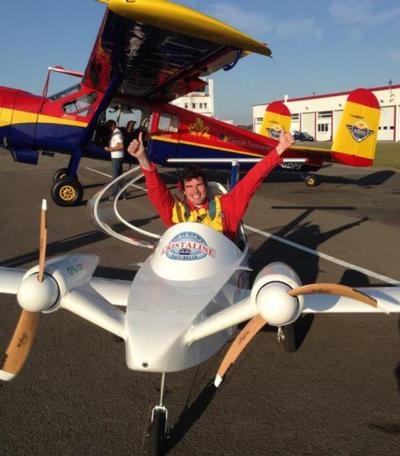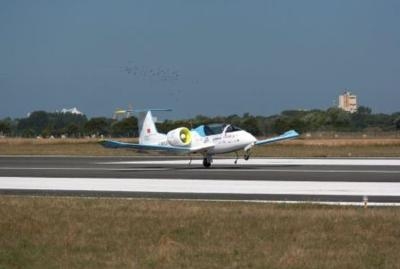But The Aerospace Giant Still Claims Its Place In History
Sometimes, all it takes is a little inspiration.

ANN received an email from Pipistrel USA Master Distributor Michael Coates saying that while the Pipistrel Alpha would not be the first electric airplane to cross the English Channel, neither would the Airbus E-Fan aircraft, which completed the round trip Friday.
No the distinction went to French pilot Hugues Duwal, who crossed the channel from Calais, France to England and back in his one-place electric Cri-Cri E-Cristaline aircraft just hours before Airbus made the attempt in the other direction in the E-Fan.
Coates tells ANN that Duwal made the attempt after learning that Airbus had managed to block Pipistrel from making the attempt through an arrangement with Siemens, which manufactured the electric engine aboard the Alpha. Siemens sent a letter reportedly at the behest of Airbus saying Pipistrel could not use its engine to fly over water. The E-Fan does not use Siemens engines, but a Siemens logo is on the airplane.
"As Duwal already had the permanent permit to fly his aircraft there was no need to ask for a permit to fly over the English Channel, but only to fill the flight plan. It was possible to keep the flight information secret up to the end," Coates said.
There was just one small detail that is allowing Airbus to also claim a piece of history. The U.K. newspaper The Telegraph reports that Duwal's Cri-Cri ... the smallest twin-engine airplane in the world ... had to be towed aloft by another airplane like a glider.

That led Airbus to say in its news release that the E-Fan was the world’s first all-electric two engine aircraft taking off by its own power to successfully cross the Channel, some 106 years after Louis Blériot’s epic flight. The E-Fan’s flight of 46 miles between Lydd, England, and Calais in France was completed in 36 minutes.
The E-Fan is powered by lithium-ion batteries, which offer an increased battery capacity of 60 percent compared to the aircraft’s original configuration. Flown by test pilot Didier Esteyne, the E-Fan weighs around 1,320 pounds and travelled at a maximum altitude of about 3,500 feet.
Louis Blériot was one of the most famous aviation pioneers of his time. He performed the Channel crossing on 25 July 1909 in his Blériot XI, an aircraft that not only became the record–breaking aeroplane of 1909 and 1910, but also the first aircraft to be put into mass production and launch France’s aviation industry. Bleriot’s company was based in Suresnes, near Paris, at the same site where part of the E-Fan team is now located.
“The E-Fan project and today’s historic Channel crossing show that the pioneering spirit and ingenuity demonstrated by Louis Blériot and the other early aviators is still alive today. The 10th of July 2015 will now join the list of famous days in aviation history and I’m sure Blériot would be proud of this achievement,” said Jean Botti, Airbus Group Chief Technical Officer. “We continue to embody the spirit of innovation and tackle technical challenges which both advance aerospace as we know it today and pioneer the next generation of electric and hybrid flight,” added Jean Botti.
Of Duwal's accomplishment, the Telegraph reports that an Airbus spokeswoman said they "applaud" the flight. "He plays in his own category. All efforts in electric flying support our goal to advance electric and hybrid flight." The U.K. newspaper The Guardian reports that another Airbus spokesman, Jeremy Greaves, said Duwal's crossing "would not count because we understand he set off from another plane."
Serving of sour grapes, anyone?
(Top image of Hugues Duwal from Twitter. E-Fan image provided by Airbus)
 ANN's Daily Aero-Linx (05.06.25)
ANN's Daily Aero-Linx (05.06.25) ANN's Daily Aero-Term (05.06.25): Ultrahigh Frequency (UHF)
ANN's Daily Aero-Term (05.06.25): Ultrahigh Frequency (UHF) ANN FAQ: Q&A 101
ANN FAQ: Q&A 101 Classic Aero-TV: Virtual Reality Painting--PPG Leverages Technology for Training
Classic Aero-TV: Virtual Reality Painting--PPG Leverages Technology for Training Airborne 05.02.25: Joby Crewed Milestone, Diamond Club, Canadian Pilot Insurance
Airborne 05.02.25: Joby Crewed Milestone, Diamond Club, Canadian Pilot Insurance




